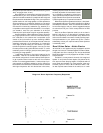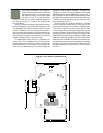
direct radiator) to bloated. The Salon’s soundstage com-
bines the best attributes of both types. It has better image
specificity than most dipoles, though it doesn’t render pin-
point images. There is a natural sense of size and weight to
images generated by the Salon. The soundstage itself seems
huge and encompassing on material such as that recorded
by Keith Johnson for Reference Recordings.
While the Salon doesn’t produce that phony see-into-it
t r a n s p a r e n c y, you can easily distinguish between instruments
in space – if you want to. But the separation isn’t tossed in your
face. Indeed, this is true of all aspects of this speaker. It’s all
there and you can listen to it, if you want to. But you’ll proba-
bly be too busy listening to the music.
What more could I want from
the Salon? For now, it doesn’t
resolve the p u l s a t i o n y o u
hear from live instruments. I
say for now because I haven’t
yet had an opportunity to
apply basic acoustic treat-
ments to the first-reflection
points in the room. The sensa-
tion I am discussing is subtle
and could easily be lost within
the ambient wash of an overly
live room. Because of room
issues not yet addressed, I sus-
pect that I have only heard a frac-
tion of this speaker’s potential. Never-
theless, it is already obvious that the Revel
Salon is the finest speaker I have ever used and
one of the best available at any price.
Revel Ultima Sub-15/LE-1
Subwoofer System – Bring-
ing in Reinforcements
If the Salon is so wonderful all alone, why
add the Sub-15 subwoofer (much less four of
them)? How ’bout: size matters. I used to
despise subwoofers, but home theater has infused
the old beasts with new vitality. More research has
been devoted to subwoofer design in the last few years than
in the preceding decades. As a High End kind of guy, I would-
n’t much care about all this subwoofer research if digital sig-
nal processing in controllers hadn’t made subwoofer
crossovers so much less audible and so much more flexible.
So, why add subwoofers to a state-of-the-art full-range
speaker? Removing the bottom octave from the Salon’s
duties frees up a good deal of power from the main amplifi-
e r. Deep bass sucks up more power than anything else does.
By shifting the bass load to the LE-1 power amplifier, the
main power amplifier can perform at a higher level. Likewise
for the Salon woofers. It all adds up to more dynamic range
without compression that distorts the sound. Finally, it is
possible to place subwoofers in other locations that will
smooth out the bass response of the whole system. With four
subwoofers, it should be possible to do an even better job of
balancing the bass. Using multiple subs also results in lower
distortion because each sub doesn’t have to output as much
sound as one alone would.
My description of the Salon might lead you to think that
the bass in my room was seamless and free of resonance. I
wish. Using a wide variety of recordings, I can
draw a map of the disaster area called the bot-
tom three octaves. Don’t forget – this is war. I
mentioned the pronounced bump around 50
Hz. Listening to the bass guitar tracks on
Elvis Costello and Burt Bacharach’s Painted From Memory
[Mercury 314538002-2] was like riding a roller coaster. All
bumps and dips and the bumps were ugly. Similarly, trying to
follow the bass synthesizer lines in Celine Dion’s “My Heart
Will Go On” from the Ti t a n i c soundtrack [Sony SK 63213], a
worthwhile test disc for bass performance, was an exercise
in frustration. Some notes overpowered the arrangement
while others were nearly inaudible. But I know you know
what I’m talking about because this condition exists in every
room. I don’t care how much you move your speak-
ers around; the modes will get you every time. Over
time, you will probably accept all but the most pro-
nounced perturbations in tonal uniformity.
I worked well nigh a month trying to find the best
location for those four subs. I started by using the
Room Optimizer and quickly discovered that its value
dropped with the frequency. The charts reflected the
problems I kept bouncing into, but the program didn’t
offer me any real solutions (possibly a user limitation –
I need more time to work with the program). The main
problem was that I could get deep bass and midbass
bloat, or a good midbass blend and no low bass. Ulti-
m a t e l y, the four subwoofers ended up flanking
the Salons – one to each side of
both. This provided
the smoothest
blend with the
best extension,
but the response
below 30 Hz was
weak. Alert: This
was solely a room
p r o b l e m .
It is worth working
this hard to get the bass right,
because if the lower octaves are
excessive, the midrange is clouded
by the bass resonances and perception of
the highest treble is warped. It can actually sound as if the tre-
ble is reduced in level, though that is not the case. Changing the
perceived tonal balance of a system this severely has a direct
correlation with the accuracy of timbre. Timbre for each instru-
ment is created by a finely balanced group of unique frequencies
and is easily disturbed by the gross irregularities arising from
poor bass reproduction, whether it is the fault of the speaker or
the room.
Bass has a profound effect on our perception of the tem-
poral aspects of music. I will acknowledge that a hi-fi cannot
change the beat of the music. But I just as steadfastly main-
tain that a system can alter our perception of the music’s
rhythms. Precision down through the bottom octave is essen-
tial to accurately define the beginning of a note. Smear that
moment and our perception of the moment and when it
occurs can change. Worse, if bass resonances get in the way
of the proper bloom and decay of a note, the transition from
one note to the next is smudged. Again, the points of refer-
ence in the music’s time are less clearly defined. Finally, musi-


















